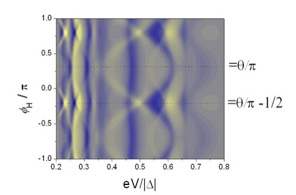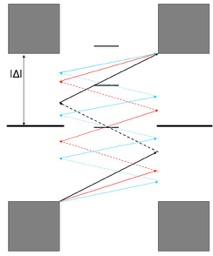

Fabrizio Dolcini

Hybrid structures: nanosystems coupled to superconductors
Multiple Andreev Reflections in a Quantum Dot
When a quantum dot is contacted to two superconducting electrodes (see Figure 1 above) the subgap I-V curve is characterized by Andreev peaks, originating from the resonance of the dot level with a multiple Andreev reflection (MAR) trajectory, i.e. a sequence of odd Andreev reflections occurring at the interfaces with the leads (see Figure 2 on the right).
Typical realization of quantum dots are based on semiconductors, where Rashba and Dresselhaus spin-orbit coupling
play a relevant role. In particular, in the the presence of spin-orbit coupling the dot levels lack of a definite spin orientation. In collaboration with Luca Dell'Anna (SISSA) we analyzed the subgap structure of a multi-level quantum dot coupled to two superconductors, finding an extremely rich behavior for the current-voltage characteristics. Among various results, we show that due to the conservation of time-reversal symmetry the MAR subgap structure is modified but not suppressed by spin-orbit interaction. The resonance conditions and the linewidths change, affecting the location and the number of the Andreev peaks.
Furthermore we found that, when an in-plane magnetic field is applied to a strongly anisotropic dot, the peaks of the non-linear conductance oscillate as a function of the magnetic field angle φH, and the location of the maxima and minima allows for a straightforward read-out of the Dresselhaus/Rashba angle θ, defined as
References
F. Dolcini, and L. Dell'Anna, Multiple Andreev reflections in a quantum dot coupled to superconducting leads: Effect of spin-orbit coupling, Phys. Rev. B 78, 024518 (2008).





Josephson Effect in a Carbon Nanotubes
Carbon Nanotubes: Single-walled metallic carbon nanotubes (SWNT) can be regarded to as a graphene sheet rolled up in the shape of a cylinder, with a radius of a few nm. According to the wrapping angle, one can obtain different types of nanotubes. Due to the quantization of the electron motion in the circular direction, SWNT effectively behave as one-dimensional conductors up to energies of the order of eV. Electronic correlations are therefore very important in these materials.
We have recently studied the dc Josephson effect in a single-walled metallic carbon nanotube connected to two superconducting electrodes.
By using the Luttinger liquid theory, we have particularly analyzed the effects of the electron-electron interaction on the supercurrent. We found that in the long junction limit the strong electronic correlations of the nanotube, together with its peculiar band structure, induce oscillations in the critical current as a function of the junction length and/or the nanotube electron filling. These oscillations represent a signature of the Luttinger liquid physics of the nanotube and can be exploited to reverse the sign of the supercurrent, realizing a tunable pi-junction.
References
S. Pugnetti, F. Dolcini, and R. Fazio, dc Josephson Effect in Metallic Single-Walled Carbon Nanotubes, Solid State Communications 144, 551 (2007).


